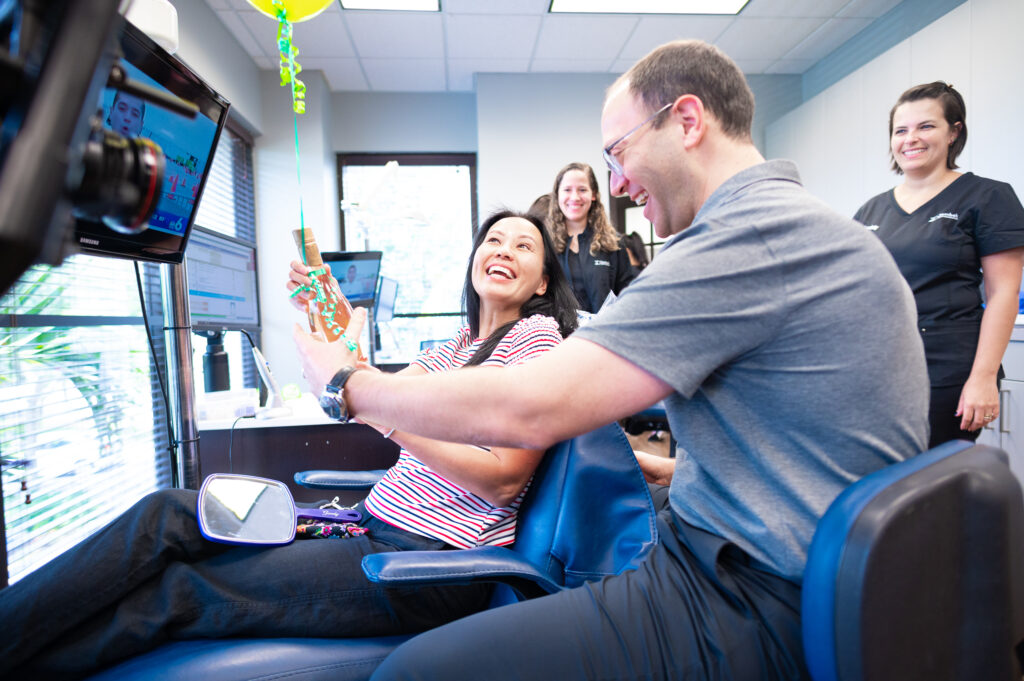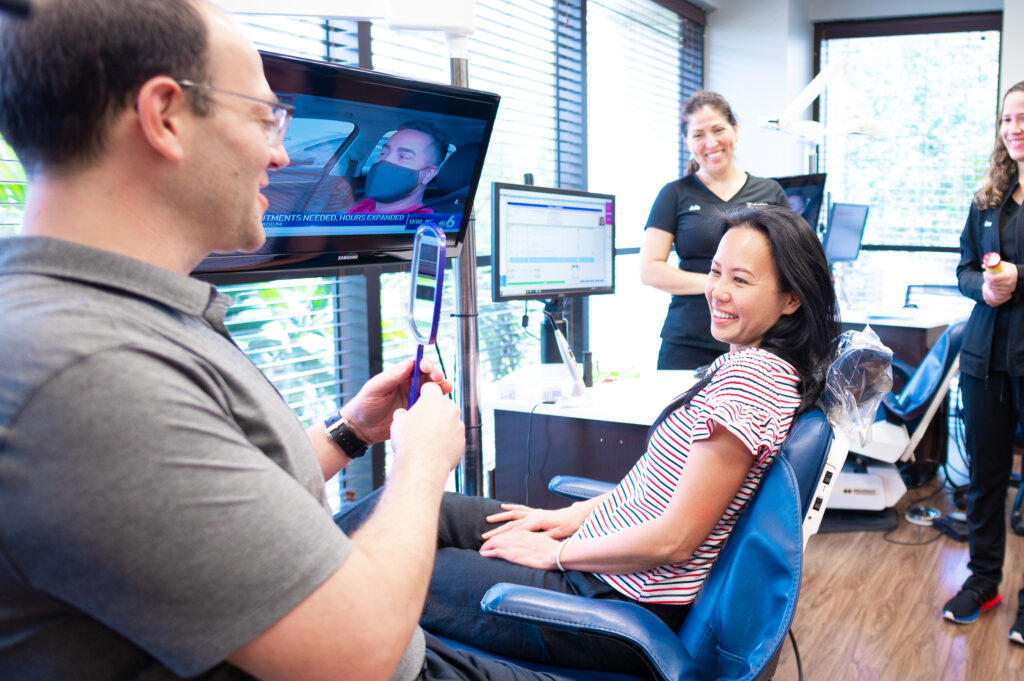One of the best parts of our work at Zombek Orthodontics is seeing a patient’s smile on the day their braces come off. That moment doesn’t happen by chance — it comes from a carefully designed treatment plan that includes regular orthodontic checkups.
We understand that appointments aren’t usually the highlight of anyone’s week. Life is busy, and sometimes unexpected things come up that require rescheduling. That’s perfectly normal. However, whenever possible, keeping your visits on track makes a significant difference in how smoothly your treatment progresses.
There isn’t a one-size-fits-all answer. The timing depends on your treatment plan and how your teeth are responding.
Your schedule may be different, and we’ll explain what’s best for your specific case at the start of treatment.

When you look in the mirror every day, it’s hard to notice the small changes your teeth are making. At your appointments, we can see those changes clearly and confirm that everything is moving in the right direction. Sometimes teeth move faster than expected, and sometimes they take a little more encouragement.
Every checkup provides us with the opportunity to fine-tune your treatment. That might mean adding elastics to guide your bite, using a power chain to close spaces, or simply confirming that no changes are needed. Not every patient requires these adjustments, but when they’re helpful, making them at the right time helps keep you on schedule.
Even the best braces or aligners can sometimes feel uncomfortable. Maybe a wire is poking your cheek, or your aligner is rubbing in one spot. These are the types of issues we can address quickly during an appointment. We’ll also send you home with tips and tools, such as orthodontic wax, to help you stay comfortable between visits.
Regular visits also allow us to catch minor problems before they become major ones. A bracket that’s starting to loosen, a wire that’s bent, or gums that look a little inflamed — these are all things we can address early so they don’t slow down your progress.
Missing one visit usually isn’t a big deal. We’ll just reschedule and pick up where we left off. However, if appointments are frequently skipped, your treatment may take longer, as we may miss the opportunity to make adjustments when your teeth are ready for them.
The best thing to do is call us as soon as you know you won’t be able to make it, and we’ll get you back on the schedule quickly.
Not at all. Missing once happens to everyone. The key is not making it a habit.
Most visits are short — usually 20 to 40 minutes — unless we’re making bigger adjustments.
Yes. Even though you change trays at home, we need to make sure your teeth are tracking correctly and that no modifications are required.
Yes. Even when everything feels comfortable, we may need to make changes that we would overlook on your own.
Every patient’s treatment plan is unique, but one thing remains the same: regular visits are an essential part of ensuring your braces or Invisalign work as intended. At Zombek Orthodontics, we’ll guide you through every stage of treatment and ensure you feel supported throughout the process.If you’re ready to start your journey to a new smile, schedule an appointment at our Weston or Hollywood offices. We’d be honored to help you get there.
It’s back-to-school season, and for some students, that includes a new smile as they head back with braces. Adjusting to braces can take a bit of patience, but with the right habits and tools, you’ll feel more comfortable and confident throughout the school year.
At Zombek Orthodontics, we're here to support your journey. These five practical tips can help keep your braces in great shape while helping you feel confident and ready for a fantastic school year.

Braces might make eating a bit tougher at first, especially when your teeth feel tender. Choosing soft foods can help protect your orthodontic work and ease soreness.
Tips for lunch and snacks:
Looking for more guidance? Check our detailed guide on Top Foods to Enjoy and Avoid With Braces for examples of what to choose and what to skip.
Brackets and wires can change how your tongue and lips move, which may affect your speech at first. This is normal and usually temporary.
Simple ways to get used to talking with braces:
A small, dedicated kit helps maintain oral hygiene and manage minor braces issues during the day.
Suggested items for your kit:
Optional items (check school policy):

Physical activity is no problem with braces if you take precautions.
Why a mouthguard is important:
Boil-and-bite mouthguards are widely available, while custom-fit options offer extra comfort. Rinse your mouthguard before and after use and store it in a clean case. Ask your coach, teacher, or orthodontic team for help choosing the right one for your needs
Feeling self-conscious about braces is common, especially in a school setting.
Things to remember:
Minor issues can happen during the school day. Here's what to do:
Yes, but stick to soft, non-sticky options and eat slowly to protect your braces.
In most cases, no. Chewy or crunchy bars can damage brackets and wires.
Essentials like a toothbrush, floss, wax, rubber bands, and a mirror are helpful. Check with your school about any restrictions on other items.
Yes, a mouthguard helps protect your teeth and braces from sports-related injuries.
Starting a school year with braces can feel like a big adjustment, but with a little preparation and support, it becomes much easier. At Zombek Orthodontics, we are here to help you through the entire school year.
Whether you need help with a care kit or advice on braces-safe meals, we’re just a call away. Let’s make this school year a confident, comfortable, and smile-worthy success
The day your braces come off is a big moment. After months (or maybe years) of dedication, you finally get to see your full smile without brackets or wires. It’s exciting, but it’s also normal to have questions about what comes next. Will your teeth stay straight? Can you whiten them? What should you be doing now?
At Zombek Orthodontics, we want you to feel confident not only about your results, but also about maintaining them. Life after braces typically involves wearing a retainer, maintaining regular dental care, and making a few adjustments to help your smile stay healthy.
Here are five things to keep in mind once your braces come off.

One of the first things people ask is, "Do I really have to wear a retainer?" The short answer is yes, but it’s not as overwhelming as it might sound.
Your teeth have worked hard to find their proper position. Wearing a retainer helps hold them there while the surrounding bone and tissue adjust. Most people start by wearing their retainer most of the day, taking it out for meals and brushing. After a few months, that usually shifts to wearing it just at night.
Over time, a nighttime routine is all you need to help maintain your results. Your orthodontist will walk you through exactly what to expect, based on your unique treatment plan.
Not all retainers are the same. Your orthodontist will help you choose the type that best suits your teeth and lifestyle.
Each type has pros and cons, and we’ll talk you through the options before your braces come off.
It’s not unusual to notice small white spots on your teeth once your braces are removed. These are often areas where minerals in your enamel have worn away, which can happen when plaque builds up around brackets.
This does not mean you weren’t trying. Brushing and flossing with braces is tough, even when you’re doing your best. If you ever feel like you’re having a hard time cleaning your teeth during treatment, we’re always here to help with tips and tools.
While white spots usually don’t go away entirely on their own, there are ways to make them less noticeable, including whitening treatments and fluoride care. Your general dentist can talk through options with you.
Many people choose to whiten their teeth after braces. It’s a nice way to enhance your smile and reduce contrast between any white spots and the rest of your enamel.
We usually recommend waiting about three to six months before whitening. This gives your teeth time to settle after treatment and helps minimize sensitivity. Whitening too soon can feel uncomfortable, especially if your teeth are already sensitive from having brackets removed.
When you are ready, your general dentist can recommend professional whitening options. These treatments tend to be more effective and gentler than store-bought kits, especially if you’re dealing with sensitivity.
You may have heard that wisdom teeth should come out after braces. That used to be standard advice, but today, it depends on the person.
Most of the time, shifting after braces is caused by not wearing a retainer, rather than by wisdom teeth. Still, wisdom teeth can cause issues such as crowding in the back of your mouth, making it harder to keep your mouth clean or even leading to discomfort.
We can use X-rays to examine your wisdom teeth and help you determine the best course of action. If they’re coming in normally and not causing any problems, there may be no need to remove them.

Once the braces come off, you have a lot more freedom, especially when it comes to eating. It’s fine to enjoy some of the foods you had to avoid, but try to keep up those good habits too.
Sticking to a balanced diet and limiting sugary snacks will help keep your teeth strong. If you enjoy treats like candy or soda occasionally, be sure to brush and floss daily and keep up with your regular dental checkups.
A little consistency goes a long way.
Whether you’re still in treatment or ready to celebrate the end of your braces journey, Zombek Orthodontics is here to help. We’re not just here for the before and during — we’re here for the after too.
If you’re looking for an orthodontist in Hollywood, FL, or Weston, FL, schedule a virtual consultation with our team. We’d love to help you keep your smile looking and feeling great for years to come.
Braces are just for kids, right? If you’re an adult, you’re supposed to just “live with” crooked teeth or a bad bite, right? Absolutely not! You deserve the smile of your dreams at any age, and Zombek Orthodontics wants to help you make that happen!
When is it too late for braces? Never! A straight smile is about a lot more than aesthetics. A straight smile not only improves your oral health but also enhances your overall well-being. It can improve breathing or speech in some instances, and it can even boost your self-confidence. That’s why we believe you’re entitled to a straight smile at any age.
What can you expect with adult orthodontics vs. orthodontics for kids? Are there other options than two years of metal braces? You’ll be amazed at what today’s orthodontics can offer!

Are there benefits to adult braces? Absolutely! Crowded or crooked teeth can be harder to keep clean, which can lead to gum disease or other dental issues over time. Adult orthodontic treatment not only gives you a beautiful smile — it also supports better long-term dental health and helps you keep your natural teeth healthy for years to come.
Here are some of the benefits to getting a straight smile from adult braces:
Adult braces can solve problems you may not be aware are related to your teeth!
There are probably more adult orthodontic treatment options available now than what you remember as a kid. Orthodontics today doesn’t mean spending many years with a “mouthful of metal.” Today’s braces are smaller, more efficient, faster, and more comfortable than those you missed getting as a kid.

Zombek Orthodontics offers LightForce self-ligating braces. These braces are made to be more comfortable than previous braces. They are fitting with precision so each braces bracket applies the proper pressure in the exact place on the tooth to move it quickly and comfortably.
Clear ceramic braces are an option for patients who want a lower profile with the same moving power of metal braces. Our self-ligating clear braces will move your teeth just as effectively, but the ceramic brackets are designed to match the color of your teeth closely. It makes them less visible than traditional metal braces.
If you’re unsure about wearing braces, clear aligners like Invisalign treatment might be a better option for you. Clear aligners for adults are popular because they’re nearly invisible on the teeth, so people may not even know you’re undergoing orthodontic treatment!
Today’s Invisalign can treat more cases than ever, including:
Certain cases may still require braces instead of Invisalign. As long as you’re willing to wear your Invisalign at least 22 hours a day, this could be the treatment option for you!
We often hear this question from patients of all ages — how long will I have to wear braces? More importantly, in this case, how long do adults wear braces?
Young children’s jaws are still developing, which allows the teeth to move easier. Adults’ jaws have developed and “set,” meaning the bones have hardened. Does this mean adults can’t get braces? Definitely not! It does mean that it might take a little longer for those braces to work than it does for kids.
On average, children wear braces for 12 to 24 months. That could be extended by a few months for adults, but not by much. You may wear Invisalign for the standard 9-15 months or maybe a couple of months longer.
The primary factor determining the length of your treatment is the severity of your dental issues. Someone with a mild overbite may only wear braces for a few months, whereas someone with severely crooked teeth and an open bite could wear braces for up to two years.
How do you know how long you will wear braces? We’ll determine that when we draw up your braces treatment plan! You’ll know how long your treatment will take, and you’ll have an idea of how you will look before and after adult braces.
As with your treatment time, the amount of treatment you will need will determine the cost of your braces. We will let you know your costs up front. We’ll never surprise you with hidden fees! We’ll also work with you to help you find the best way to pay for braces or clear aligners. Your orthodontic treatment should be affordable to you!
Braces treatment isn’t limited to your teenage years. People of all ages are entitled to a straight, healthy smile. Zombek Orthodontics wants to help you get that smile and keep it the rest of your life.
Schedule an appointment with Zombek Orthodontics in Weston, FL, or Hollywood, FL. We’d love to see you with that beautiful new smile!
 This site’s strategy, design, photo & video were created by the marginally-above-average folks @ Clear Partnering Group.
This site’s strategy, design, photo & video were created by the marginally-above-average folks @ Clear Partnering Group.